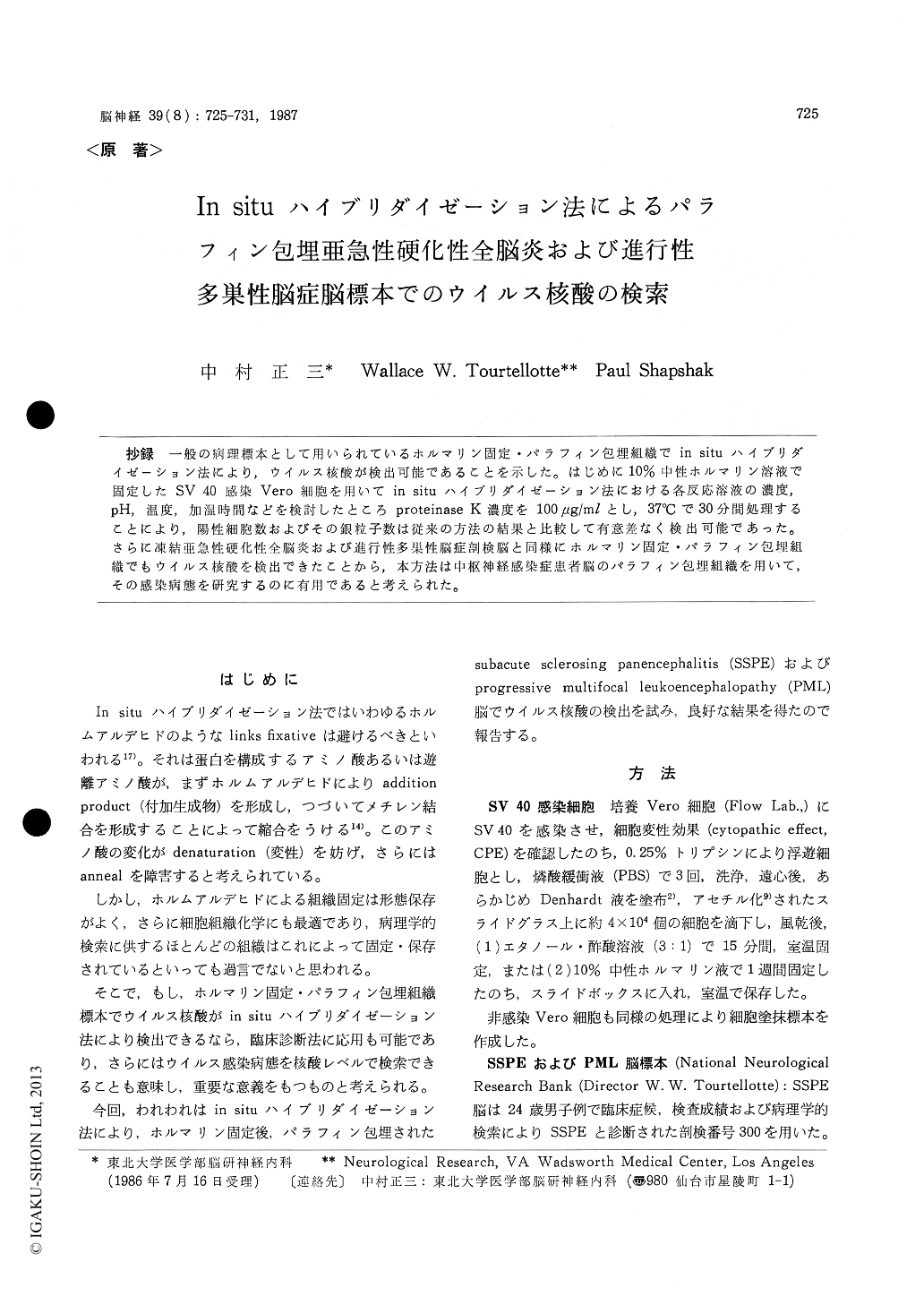Japanese
English
- 有料閲覧
- Abstract 文献概要
- 1ページ目 Look Inside
抄録 一般の病理標本として用いられているホルマリン固定・パラフィン包埋組織でin situハイブリダイゼーション法により,ウイルス核酸が検出可能であることを示した。はじめに10%中性ホルマリン溶液で固定したSV 40感染Vero細胞を用いてin situハイブリダイゼーション法における各反応溶液の濃度,pH,温度,加温時間などを検討したところproteinase K濃度を100μg/mlとし,37℃で30分間処理することにより,陽性細胞数およびその銀粒子数は従来の方法の結果と比較して有意差なく検出可能であった。さらに凍結亜急性硬化性全脳炎および進行性多巣性脳症剖検脳と同様にホルマリン固定・パラフィン包埋組織でもウイルス核酸を検出できたことから,本方法は中枢神経感染症患者脳のパラフィン包埋組織を用いて,その感染病態を研究するのに有用であると考えられた。
We have been able to detect the viral nucleic acid sequences in formalin-fixed paraffin embedded tissue sections of the brain from SSPE and PML respectively by in situ hybridization using cloned and radiolabelled complementary DNA (cDNA) measles nucleocapsid (NP) and JC virus probes which are gene specific respectively. We have mainly followed in situ hybridization procedure reported by Haase et al, but partly modified the technique including the extensive wash by buffer solution and the elevated concentration of pro-teinase K.
Firstly, to compare with the number of hybri-dized cells and grain counts, the in situ hybridi-zation were performed in SV 40 infected cells treated with ethanol-acetic acid for 15 minutes or 10% neutral formalin for at least one week tosimulate procedure used by pathologists.
Similar findings were obtained in both treatment of 1 μg/ml concentration of proteinase K in or-dinary fixed cells and in 100 μg/ml in formalin-fixed cells.
In addition we investigated the ability of in situ hybridization technique to detect measles in SSPE and papova virus in PML obtained post-mortem that were been formalin-fixed paraffin-embedded routinely. In paraffin-embedded SSPE cerebral cortex positive hybridization were ob-tained in oligodendroglias and neurons using 125I-labelled measles NP probe in 6 days' autoradio-graphic exposure (Fig. 2 and 3) in our modified technique. Additionally, in PML tissue JC virus nucleic acid sequences were also detected in many oligodendroglias and swollen neurons using 3H-labelled JC virus probe.
Accordingly, the detection of virus nucleic acid sequences in paraffin-embedded brain tissues is feasble using modified procedure of in situ hybri-dization. It suggests to be able to clarify the pathomechanism of latent infection of the central nervous system in paraffin-embedded tissues by the application of a 3H-labelled probe at the molecular level.

Copyright © 1987, Igaku-Shoin Ltd. All rights reserved.


